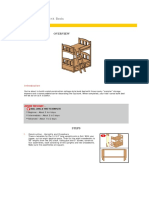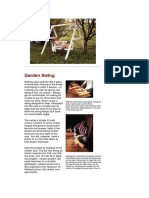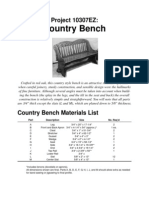Lock Rabbet Drawer Joints
Lock Rabbet Drawer Joints
Uploaded by
SANTI9090Copyright:
Available Formats
Lock Rabbet Drawer Joints
Lock Rabbet Drawer Joints
Uploaded by
SANTI9090Copyright
Available Formats
Share this document
Did you find this document useful?
Is this content inappropriate?
Copyright:
Available Formats
Lock Rabbet Drawer Joints
Lock Rabbet Drawer Joints
Uploaded by
SANTI9090Copyright:
Available Formats
Lock Rabbet Drawer Joints
Although you can build drawer joints using any number of methods, we think lockrabbet joints like the ones below make sense for attaching the sides, fronts, and backs of most drawers. Although not as strong as a dovetailed joint, a wellmade lockrabbet joint will hold up drawer takes heavy, pounding. And, it's cut than dovetails.
fine unless the regular much simpler to
Note: Before you start, make sure that all of your drawer front stock is the same thickness (about 3/4"). Also, your sides and backs should be identically thick (about 1/2").
1 To protect the face of your table saw fence from blade cuts, attach a 6"-high wood
auxiliary fence to it. Install a 1/4"-wide dado set, and adjust the fence so the dado set just grazes it. Use your 1/2"-thick stock for the drawer side or back to adjust the height of the dado set to match the thickness of that material as shown in above illustration. Make a 1/4x1/2" rabbet cut in a 3/4x3x3" scrap "gauge block" positioned face down on your saw. Nestle your drawer side or back into the rabbet to double-check that the depth of the cut matches the thickness of the 1/2" stock. Save this gauge block.
2 Readjust the fence-to-dado set distance to
of the rabbet cut in the gauge block. As shown illustration, the edge of the rabbet should meet closest to the fence. Use a square to hold the to the fence.
match the width in above the dado set teeth gauge block 90
back face against 3 Position a drawer front on edge with its the fence. Now, cut 1/4x1/2" grooves in both ends as shown left. Do this to all of your drawer fronts.
4 Once again, the gauge block helps you precisely set up for a
cut. Position it as shown left to reset the height of the dado set to 1/4" high. Do not change the position of the fence.
Note: For each of the following steps, first make test cuts in scrap stock of the same thickness as your actual work pieces. Check the fit of the scrap pieces with the project pieces cut in earlier steps.
5 Place a drawer side outside face up on the saw, butt either end against the fence, and
cut a 1/4x1/4" groove as shown above. Groove the other end of the drawer side in the same fashion, and repeat these steps on your other drawer sides.
6 Position a drawer back on edge with its inside face against
the fence. Cut a 1/4x1/4" rabbet in both ends as shown left. Make these cuts on all of your drawer backs. Now's a good time to cut the 1/4x1/4" groove in each of your fronts, sides, and backs for holding the drawer bottom. Leave the fence and dado set where they are, position your drawer parts inside face down with their bottom edges against the fence, and cut the bottom-holding groove.
7 Raise the dado set for a 3/8"-deep cut. Readjust the fence so
the dado set just grazes it. Position your drawer fronts face side up on the saw and complete the cuts on their ends as shown left.
8 To assemble each drawer, first test-fit the parts. Then, apply glue to all of the
grooves and rabbets. We suggest you make the bottoms from plywood instead of solid stock. In that way, you can glue the bottom in place without concern about expansion and contraction problems. Assemble the glued parts, clamp them together, and measure diagonally from corner to corner to check for square. If one diagonal is longer than the other, place a long clamp along that diagonal to bring the drawer into square.
You might also like
- OPERATOR'S MANUAL FINISHERS pf-3200-pf-3180 and pf-3172Document89 pagesOPERATOR'S MANUAL FINISHERS pf-3200-pf-3180 and pf-3172ingmec6No ratings yet
- Treasured Chest Build A Jewelry BoxDocument9 pagesTreasured Chest Build A Jewelry BoxThanasis KyrgiazoglouNo ratings yet
- Illustrated Spare Part List FOR: Kirloskar Oil Engines LimitedDocument85 pagesIllustrated Spare Part List FOR: Kirloskar Oil Engines LimitedPlr. Baswapur100% (3)
- Boxes to Build: Sturdy & Stylish Projects to Organize Your Home & ShopFrom EverandBoxes to Build: Sturdy & Stylish Projects to Organize Your Home & ShopNo ratings yet
- Pine Desk Organizer: Project 13782EZDocument6 pagesPine Desk Organizer: Project 13782EZBSulli100% (1)
- Ulmia Workbench (55p)Document55 pagesUlmia Workbench (55p)pippitiamo100% (1)
- HiPerMat 2012 KasselDocument1,059 pagesHiPerMat 2012 KasselAna Mafalda MatosNo ratings yet
- AISC StandardsDocument8 pagesAISC StandardsNigar NaimNo ratings yet
- How To Build A Bookcase: Intro: Tools and MaterialsDocument7 pagesHow To Build A Bookcase: Intro: Tools and Materialssaric_terrill4785100% (1)
- Arbor - Lath Arch Rose ArborDocument6 pagesArbor - Lath Arch Rose ArborDaniel LourençoNo ratings yet
- Roll Around Kitchen Cart: MLCS Items UsedDocument15 pagesRoll Around Kitchen Cart: MLCS Items UsedTETSUO111No ratings yet
- Bunk Beds: Start With The PanelsDocument5 pagesBunk Beds: Start With The PanelspoimandresNo ratings yet
- Panel JigDocument16 pagesPanel JigfasdfNo ratings yet
- Swing Garden SwingDocument7 pagesSwing Garden SwingAlicia MariaNo ratings yet
- Chapter One: A Simple Lift-Lid Box: Excerpted FromDocument20 pagesChapter One: A Simple Lift-Lid Box: Excerpted FromChuck Osuchowski0% (1)
- Çalışma Tezgahı PlanıDocument14 pagesÇalışma Tezgahı PlanıÖmür Eryüksel50% (2)
- Bench - Langcrest - LoveseatDocument5 pagesBench - Langcrest - LoveseatvdbrogerNo ratings yet
- How to Build a Children's Swing, Slide, Roundabout and Toboggan for the Garden - An Illustrated GuideFrom EverandHow to Build a Children's Swing, Slide, Roundabout and Toboggan for the Garden - An Illustrated GuideNo ratings yet
- Drop Leaf TableDocument3 pagesDrop Leaf Table- yAy3e -No ratings yet
- Step-Back Cupboard: Build This Elegant 18th-Century Cupboard, and Hone Your Hand-Tool Skills at The Same TimeDocument8 pagesStep-Back Cupboard: Build This Elegant 18th-Century Cupboard, and Hone Your Hand-Tool Skills at The Same TimehelenmckaneNo ratings yet
- Shaker Inspired Wall ShelfDocument3 pagesShaker Inspired Wall ShelfjcpolicarpiNo ratings yet
- Country Dry SinkDocument4 pagesCountry Dry SinkjcpolicarpiNo ratings yet
- Wall-Hung Telephone Cabinet: Project 11257EZDocument6 pagesWall-Hung Telephone Cabinet: Project 11257EZBSulli100% (1)
- Bench - Mendocino BenchDocument5 pagesBench - Mendocino BenchvdbrogerNo ratings yet
- How To Make A Meat SafeDocument5 pagesHow To Make A Meat SafeChristian Theriault100% (1)
- Wall Hung Magazine and Book Rack: Project 14211EZDocument3 pagesWall Hung Magazine and Book Rack: Project 14211EZBSulliNo ratings yet
- Rotating Barrel ComposterDocument3 pagesRotating Barrel Compostertraction9261No ratings yet
- Arched Aurora NightstandDocument7 pagesArched Aurora NightstandRoberto LandaNo ratings yet
- Stickley Side Table 1Document1 pageStickley Side Table 1- yAy3e -No ratings yet
- Small Colonial Bench: Project 10297EZDocument5 pagesSmall Colonial Bench: Project 10297EZmhein68No ratings yet
- Early American Step Table: Project 18321EZDocument4 pagesEarly American Step Table: Project 18321EZBSulliNo ratings yet
- Hide Your Bins in A Handy Trash CentreDocument4 pagesHide Your Bins in A Handy Trash Centret_w_3_0_7No ratings yet
- Beds - Four Poster Bed PlansDocument8 pagesBeds - Four Poster Bed Planspoimandres100% (2)
- Plansnow DownloadDocument4 pagesPlansnow DownloadJimmy Gomez100% (1)
- Showcase Cabinets: The Delicate Interplay of Glass and WoodDocument7 pagesShowcase Cabinets: The Delicate Interplay of Glass and WoodAdrian Cocis100% (1)
- A Classic Case: A Project Plan For A Case With A Modern Take On An Arts and Crafts ClassicDocument7 pagesA Classic Case: A Project Plan For A Case With A Modern Take On An Arts and Crafts ClassicMushroom Love Stars CrUz100% (1)
- Wooden Coat Hanger: Project 16474EZDocument3 pagesWooden Coat Hanger: Project 16474EZBSulliNo ratings yet
- WJ157 Easy Chair Side TablesDocument9 pagesWJ157 Easy Chair Side Tablesmiclark100% (1)
- TWW Toy ChestDocument8 pagesTWW Toy ChestalpaazNo ratings yet
- Contemporary Coffee Table: Project 17631EZDocument5 pagesContemporary Coffee Table: Project 17631EZBSulliNo ratings yet
- Coffe TableDocument15 pagesCoffe TableJun Vargas100% (1)
- Portable WorkshopDocument7 pagesPortable WorkshopJose PichardoNo ratings yet
- Bench - Classic Cedar Garden PDFDocument11 pagesBench - Classic Cedar Garden PDFmarianrkwNo ratings yet
- Bco Carp Robust BenchDocument6 pagesBco Carp Robust BenchFabio Fernando FigaroNo ratings yet
- 8x10 Lean To Shed 2022-09-04Document29 pages8x10 Lean To Shed 2022-09-04Steven 659No ratings yet
- Long Langstroth HiveDocument7 pagesLong Langstroth HiveWolfgangNo ratings yet
- Pine Cabinet: Project 11142EZDocument5 pagesPine Cabinet: Project 11142EZBSulliNo ratings yet
- Country Bench: Project 10307EZDocument8 pagesCountry Bench: Project 10307EZBSulliNo ratings yet
- How To: Build A Raised-Bed Garden: 2. Attach The EndsDocument20 pagesHow To: Build A Raised-Bed Garden: 2. Attach The EndsAndre Duvaux100% (1)
- Chopping Man Whirligig PDFDocument1 pageChopping Man Whirligig PDFjhoel andrades100% (1)
- 011130080Document6 pages011130080roose1100% (3)
- Harvest Table: This Shaker Drop-Leaf Design Can Be Built For Two or For 20Document6 pagesHarvest Table: This Shaker Drop-Leaf Design Can Be Built For Two or For 20roose1No ratings yet
- 2 - Woodworking Plans - OakplateDocument6 pages2 - Woodworking Plans - OakplatemacpatorNo ratings yet
- Chisel CabinetDocument3 pagesChisel CabinetErika Ramirez100% (4)
- Workshop Assignment: By: Sneha Motghare Div: B Roll No:26 Batch:2 Taught By: Vilas SirDocument15 pagesWorkshop Assignment: By: Sneha Motghare Div: B Roll No:26 Batch:2 Taught By: Vilas SirVinay MotghareNo ratings yet
- Spindle Turning: Fine Points For The BeginnerDocument6 pagesSpindle Turning: Fine Points For The Beginnerapi-25885411No ratings yet
- Bench - Build A Classic Porch Glider - PopMecDocument8 pagesBench - Build A Classic Porch Glider - PopMecvdbroger100% (1)
- Chest - Blanket Chest BoxDocument13 pagesChest - Blanket Chest BoxDavid Whaley100% (1)
- An Everyday CabinetDocument8 pagesAn Everyday CabinetJonathan Hopkins100% (3)
- How To Build A DoorDocument12 pagesHow To Build A DoorWalter Ramirez100% (4)
- 24-25 - AUG07PW - Jig Journal PDFDocument2 pages24-25 - AUG07PW - Jig Journal PDFzazoumobile6218100% (1)
- Plans Now - Woodsmith - Pocket Hole Joinery Basics PDFDocument3 pagesPlans Now - Woodsmith - Pocket Hole Joinery Basics PDFPaweł Jamrożek100% (2)
- The Pig Measures 14Document1 pageThe Pig Measures 14SANTI9090No ratings yet
- La Web de OroDocument7 pagesLa Web de OroSANTI9090No ratings yet
- Learning How To Knot A Tie: WindsorDocument8 pagesLearning How To Knot A Tie: WindsorSANTI9090No ratings yet
- McHugh House - Sheet - A109 - Foundation PlanDocument1 pageMcHugh House - Sheet - A109 - Foundation PlanSANTI9090No ratings yet
- SW PDF Leed Voc ReferenceguideDocument76 pagesSW PDF Leed Voc ReferenceguidehatsuhayNo ratings yet
- Manual SRDocument76 pagesManual SRGuillermo Murillo DiazNo ratings yet
- CHAPTER 11 Metal Casting ProcessDocument50 pagesCHAPTER 11 Metal Casting Processمحمد القدومي100% (1)
- Variable Power SupplyDocument27 pagesVariable Power SupplyDharang ShahNo ratings yet
- Vortex Gasket PDFDocument13 pagesVortex Gasket PDFmansurudinNo ratings yet
- DLL g5 q1 Week 3 All Subjects (Mam Inkay Peralta)Document62 pagesDLL g5 q1 Week 3 All Subjects (Mam Inkay Peralta)Lorie Ann GonzalesNo ratings yet
- RefrigerantDocument59 pagesRefrigerantObula Reddy KNo ratings yet
- WinGD - X52 Marine Installation ManualDocument220 pagesWinGD - X52 Marine Installation ManualParis AndreadisNo ratings yet
- 20.09.2017 Rak-Addendum BoqDocument447 pages20.09.2017 Rak-Addendum BoqYash SharmaNo ratings yet
- 24 Lathe Machine Parts and Functions PDFDocument8 pages24 Lathe Machine Parts and Functions PDFTackle XINo ratings yet
- Rfi Novec R7&R8Document2 pagesRfi Novec R7&R8MOSTAFA SHARAFNo ratings yet
- Torelief - : Ultra High ResolutionDocument1 pageTorelief - : Ultra High ResolutionRizwan KhanNo ratings yet
- Presentation Crystal ReportDocument17 pagesPresentation Crystal ReportSivaraman P. S.No ratings yet
- Cat Visam en 1215 Rev00Document24 pagesCat Visam en 1215 Rev00Roberto Carlos Santibañez RojoNo ratings yet
- Diab Divinycell PL105 October 2022 - Rev1 SIDocument2 pagesDiab Divinycell PL105 October 2022 - Rev1 SIgithuNo ratings yet
- Hydraulic Symbols: Service Training Manual CM 760/780Document23 pagesHydraulic Symbols: Service Training Manual CM 760/780victor lara100% (1)
- Reliability Analysis On The Stability of Slope PDFDocument102 pagesReliability Analysis On The Stability of Slope PDFBagus Rachmad IrwansyahNo ratings yet
- Introduction To Neurofuzzy Technologies: Combining Neural Networks and Fuzzy LogicDocument8 pagesIntroduction To Neurofuzzy Technologies: Combining Neural Networks and Fuzzy Logicaleena_bcNo ratings yet
- Crystalline Solids in 3dDocument23 pagesCrystalline Solids in 3del_koptan00857693No ratings yet
- Part Submission Warrant: Part Name: Stopper Bracket Part Number 1 L0081-13 Rev.:01Document4 pagesPart Submission Warrant: Part Name: Stopper Bracket Part Number 1 L0081-13 Rev.:01karan singhNo ratings yet
- Study of Dies and InsertsDocument14 pagesStudy of Dies and InsertstraidenNo ratings yet
- Model O Installation Manual - Version 1.0Document8 pagesModel O Installation Manual - Version 1.013500033769No ratings yet
- Session Plan: Upon Completion of This Module The Trainee Must Be Able ToDocument4 pagesSession Plan: Upon Completion of This Module The Trainee Must Be Able ToLeonardNo ratings yet
- A Guide To Ship HandlingDocument179 pagesA Guide To Ship HandlingDallace MirzaNo ratings yet
- Comfortmatic 250502064Document22 pagesComfortmatic 250502064Leandro Matos FelizNo ratings yet
- Trevitest PDFDocument2 pagesTrevitest PDFAntonio PerezNo ratings yet





























































































